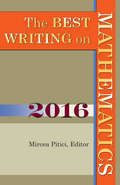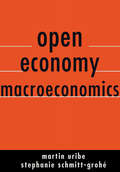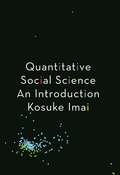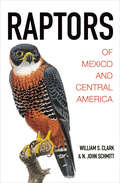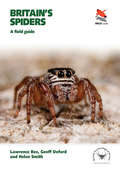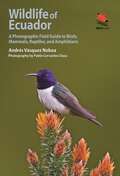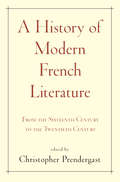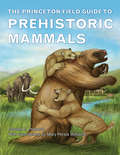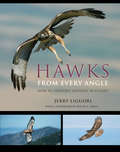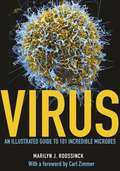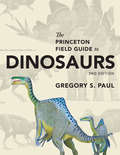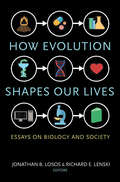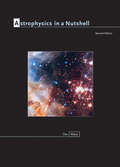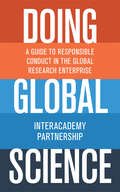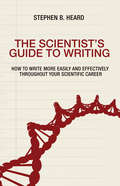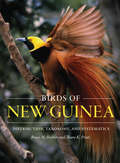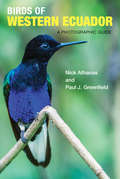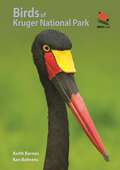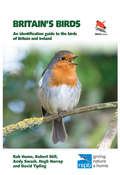- Table View
- List View
The Best Writing on Mathematics 2016
by Mircea PiticiThe year's finest mathematics writing from around the worldThis annual anthology brings together the year's finest mathematics writing from around the world. Featuring promising new voices alongside some of the foremost names in the field, The Best Writing on Mathematics 2016 makes available to a wide audience many articles not easily found anywhere else—and you don't need to be a mathematician to enjoy them. These writings offer surprising insights into the nature, meaning, and practice of mathematics today. They delve into the history, philosophy, teaching, and everyday occurrences of math, and take readers behind the scenes of today's hottest mathematical debates.Here Burkard Polster shows how to invent your own variants of the Spot It! card game, Steven Strogatz presents young Albert Einstein's proof of the Pythagorean Theorem, Joseph Dauben and Marjorie Senechal find a treasure trove of math in New York's Metropolitan Museum of Art, and Andrew Gelman explains why much scientific research based on statistical testing is spurious. In other essays, Brian Greene discusses the evolving assumptions of the physicists who developed the mathematical underpinnings of string theory, Jorge Almeida examines the misperceptions of people who attempt to predict lottery results, and Ian Stewart offers advice to authors who aspire to write successful math books for general readers. And there's much, much more.In addition to presenting the year's most memorable writings on mathematics, this must-have anthology includes a bibliography of other notable writings and an introduction by the editor, Mircea Pitici. This book belongs on the shelf of anyone interested in where math has taken us—and where it is headed.
Open Economy Macroeconomics
by Martín Uribe Stephanie Schmitt-GrohéA cutting-edge graduate-level textbook on the macroeconomics of international tradeCombining theoretical models and data in ways unimaginable just a few years ago, open economy macroeconomics has experienced enormous growth over the past several decades. This rigorous and self-contained textbook brings graduate students, scholars, and policymakers to the research frontier and provides the tools and context necessary for new research and policy proposals.Martín Uribe and Stephanie Schmitt-Grohé factor in the discipline's latest developments, including major theoretical advances in incorporating financial and nominal frictions into microfounded dynamic models of the open economy, the availability of macro- and microdata for emerging and developed countries, and a revolution in the tools available to simulate and estimate dynamic stochastic models. The authors begin with a canonical general equilibrium model of an open economy and then build levels of complexity through the coverage of important topics such as international business-cycle analysis, financial frictions as drivers and transmitters of business cycles and global crises, sovereign default, pecuniary externalities, involuntary unemployment, optimal macroprudential policy, and the role of nominal rigidities in shaping optimal exchange-rate policy.Based on courses taught at several universities, Open Economy Macroeconomics is an essential resource for students, researchers, and practitioners.Detailed exploration of international business-cycle analysisCoverage of financial frictions as drivers and transmitters of business cycles and global crisesExtensive investigation of nominal rigidities and their role in shaping optimal exchange-rate policyOther topics include fixed exchange-rate regimes, involuntary unemployment, optimal macroprudential policy, and sovereign default and debt sustainabilityChapters include exercises and replication codes
Quantitative Social Science: An Introduction
by Kosuke ImaiAn introductory textbook on data analysis and statistics written especially for students in the social sciences and allied fieldsQuantitative analysis is an increasingly essential skill for social science research, yet students in the social sciences and related areas typically receive little training in it—or if they do, they usually end up in statistics classes that offer few insights into their field. This textbook is a practical introduction to data analysis and statistics written especially for undergraduates and beginning graduate students in the social sciences and allied fields, such as economics, sociology, public policy, and data science.Quantitative Social Science engages directly with empirical analysis, showing students how to analyze data using the R programming language and to interpret the results—it encourages hands-on learning, not paper-and-pencil statistics. More than forty data sets taken directly from leading quantitative social science research illustrate how data analysis can be used to answer important questions about society and human behavior.Proven in the classroom, this one-of-a-kind textbook features numerous additional data analysis exercises and interactive R programming exercises, and also comes with supplementary teaching materials for instructors.Written especially for students in the social sciences and allied fields, including economics, sociology, public policy, and data scienceProvides hands-on instruction using R programming, not paper-and-pencil statisticsIncludes more than forty data sets from actual research for students to test their skills onCovers data analysis concepts such as causality, measurement, and prediction, as well as probability and statistical toolsFeatures a wealth of supplementary exercises, including additional data analysis exercises and interactive programming exercisesOffers a solid foundation for further studyComes with additional course materials online, including notes, sample code, exercises and problem sets with solutions, and lecture slides
Raptors of Mexico and Central America
by William S. Clark N. John Schmitt Lloyd KiffThe essential field guide to the raptors of Mexico and Central AmericaRaptors are among the most challenging birds to identify in the field due to their bewildering variability of plumage, flight silhouettes, and behavior. Raptors of Mexico and Central America is the first illustrated guide to the region's 69 species of raptors, including vagrants. It features 32 stunning color plates and 213 color photos, and a distribution map for each regularly occurring species. Detailed species accounts describe key identification features, age-related plumages, status and distribution, subspecies, molt, habitats, behaviors, potential confusion species, and more.Raptors of Mexico and Central America is the essential field guide to this difficult bird group and the ideal travel companion for anyone visiting this region of the world.Covers all 69 species of raptors found in Mexico and Central AmericaFeatures 32 color plates and hundreds of color photosProvides multiple illustrations of each speciesDepicts and describes variations in plumage by individual, morph, age, and regionDescribes behavior, food preferences, hunting strategies, vocalizations, and moltCovers rare and extralimital speciesIncludes distribution maps and flight silhouettes
Raptors of Mexico and Central America
by William S. Clark N. John Schmitt Lloyd KiffThe essential field guide to the raptors of Mexico and Central AmericaRaptors are among the most challenging birds to identify in the field due to their bewildering variability of plumage, flight silhouettes, and behavior. Raptors of Mexico and Central America is the first illustrated guide to the region's 69 species of raptors, including vagrants. It features 32 stunning color plates and 213 color photos, and a distribution map for each regularly occurring species. Detailed species accounts describe key identification features, age-related plumages, status and distribution, subspecies, molt, habitats, behaviors, potential confusion species, and more.Raptors of Mexico and Central America is the essential field guide to this difficult bird group and the ideal travel companion for anyone visiting this region of the world.Covers all 69 species of raptors found in Mexico and Central AmericaFeatures 32 color plates and hundreds of color photosProvides multiple illustrations of each speciesDepicts and describes variations in plumage by individual, morph, age, and regionDescribes behavior, food preferences, hunting strategies, vocalizations, and moltCovers rare and extralimital speciesIncludes distribution maps and flight silhouettes
Britain's Spiders: A Field Guide (PDF)
by Lawrence Bee Geoff Oxford Helen SmithBritain’s Spiders is a photographic guide to all 37 of the British families, focussing on spiders that can be identified in the field. Illustrated with a remarkable collection of photographs, it is designed to be accessible to a wide audience, including those new to spider identification. This book pushes the boundaries of field identification for this challenging group by combining information on features that can be seen with the naked eye or a hand lens with additional evidence from webs, egg-sacs, behaviour, phenology, habitats and distributions. Individual accounts cover 395 of Britain’s approximately 670 species, with the limitations to field identification clearly explained. As the first photographic field guide to British spiders to be published since 1989, this book fills a major gap in the resources available to everyone with an interest in this fascinating, diverse and important group of animals. More than 700 stunning photographs Includes a guide to spider families, based on features recognisable in the field, focussing on body shape and other characteristics, as well as separate guides to webs and egg-sacs Detailed accounts highlight key identification tips for each genus and species, and include information on status, behaviour and habitats Features up-to-date distribution maps, and charts showing adult seasonality Introductory chapters explore the biology of spiders, and where, when and how to find them, including equipment needed in the field Contains a complete list of the spiders recorded in Britain, indicating the ease of identification as well as rarity and conservation status Provides information on how to record spiders and make your records count, and guidance on how to take your interest further
Wildlife of Ecuador: A Photographic Field Guide to Birds, Mammals, Reptiles, and Amphibians
by Andrés Vásquez Noboa Pablo Cervantes DazaMainland Ecuador's spectacular wildlife makes it a magnet for nature tourists, but until now there hasn't been a go-to, all-in-one guide geared to the general reader. With this handy and accessible guide, visitors now have everything they need to identify and enjoy the majority of birds and animals they are likely to see. Written and illustrated by two of Ecuador's most experienced nature guides and photographers, this book covers more than 350 birds, mammals, amphibians, and reptiles. It features over 400 stunning color photographs and includes a range map for each species, as well as a brief account of the country's natural history and biogeography. With its extensive coverage, attractive and easy-to-use layout, beautiful photographs, and nontechnical text, this is an essential guide for anyone who wants to explore the natural wonders of Ecuador.An essential all-in-one guide to mainland Ecuador's amazing wildlifeUnique and attractive layout with more than 400 stunning color photographsCovers more than 350 of the most frequently seen birds, mammals, reptiles, and amphibiansUses a habitat-based approach to aid identificationAccessible text provides key information on identification, behavior, biology, and conservationPhotos, maps, and text are presented together for ease of use
A History of Modern French Literature: From the Sixteenth Century to the Twentieth Century (PDF)
by Christopher PrendergastAn accessible and authoritative new history of French literature, written by a highly distinguished transatlantic group of scholarsThis book provides an engaging, accessible, and exciting new history of French literature from the Renaissance through the twentieth century, from Rabelais and Marguerite de Navarre to Samuel Beckett and Assia Djebar. Christopher Prendergast, one of today's most distinguished authorities on French literature, has gathered a transatlantic group of more than thirty leading scholars who provide original essays on carefully selected writers, works, and topics that open a window onto key chapters of French literary history. The book begins in the sixteenth century with the formation of a modern national literary consciousness, and ends in the late twentieth century with the idea of the "national" coming increasingly into question as inherited meanings of "French" and "Frenchness" expand beyond the geographical limits of mainland France.Provides an exciting new account of French literary history from the Renaissance to the end of the twentieth centuryFeatures more than thirty original essays on key writers, works, and topics, written by a distinguished transatlantic group of scholarsIncludes an introduction and indexThe contributors include Etienne Beaulieu, Christopher Braider, Peter Brooks, Mary Ann Caws, David Coward, Nicholas Cronk, Edwin M. Duval, Mary Gallagher, Raymond Geuss, Timothy Hampton, Nicholas Harrison, Katherine Ibbett, Michael Lucey, Susan Maslan, Eric Méchoulan, Hassan Melehy, Larry F. Norman, Nicholas Paige, Roger Pearson, Christopher Prendergast, Jean-Michel Rabaté, Timothy J. Reiss, Sarah Rocheville, Pierre Saint-Amand, Clive Scott, Catriona Seth, Judith Sribnai, Joanna Stalnaker, Aleksandar Stević, Kate E. Tunstall, Steven Ungar, and Wes Williams.
A History of Modern French Literature: From the Sixteenth Century to the Twentieth Century
by Christopher PrendergastAn accessible and authoritative new history of French literature, written by a highly distinguished transatlantic group of scholarsThis book provides an engaging, accessible, and exciting new history of French literature from the Renaissance through the twentieth century, from Rabelais and Marguerite de Navarre to Samuel Beckett and Assia Djebar. Christopher Prendergast, one of today's most distinguished authorities on French literature, has gathered a transatlantic group of more than thirty leading scholars who provide original essays on carefully selected writers, works, and topics that open a window onto key chapters of French literary history. The book begins in the sixteenth century with the formation of a modern national literary consciousness, and ends in the late twentieth century with the idea of the "national" coming increasingly into question as inherited meanings of "French" and "Frenchness" expand beyond the geographical limits of mainland France.Provides an exciting new account of French literary history from the Renaissance to the end of the twentieth centuryFeatures more than thirty original essays on key writers, works, and topics, written by a distinguished transatlantic group of scholarsIncludes an introduction and indexThe contributors include Etienne Beaulieu, Christopher Braider, Peter Brooks, Mary Ann Caws, David Coward, Nicholas Cronk, Edwin M. Duval, Mary Gallagher, Raymond Geuss, Timothy Hampton, Nicholas Harrison, Katherine Ibbett, Michael Lucey, Susan Maslan, Eric Méchoulan, Hassan Melehy, Larry F. Norman, Nicholas Paige, Roger Pearson, Christopher Prendergast, Jean-Michel Rabaté, Timothy J. Reiss, Sarah Rocheville, Pierre Saint-Amand, Clive Scott, Catriona Seth, Judith Sribnai, Joanna Stalnaker, Aleksandar Stević, Kate E. Tunstall, Steven Ungar, and Wes Williams.
The Princeton Field Guide to Prehistoric Mammals
by Donald R. Prothero Mary Persis WilliamsAfter the mass extinction of the dinosaurs 65 million years ago, mammals became the dominant terrestrial life form on our planet. Roaming the earth were spectacular beasts such as saber-toothed cats, giant mastodonts, immense ground sloths, and gigantic giraffe-like rhinoceroses. Here is the ultimate illustrated field guide to the lost world of these weird and wonderful prehistoric creatures.A woolly mammoth probably won't come thundering through your vegetable garden any time soon. But if one did, this would be the book to keep on your windowsill next to the binoculars. It covers all the main groups of fossil mammals, discussing taxonomy and evolutionary history, and providing concise accounts of the better-known genera and species as well as an up-to-date family tree for each group. No other book presents such a wealth of new information about these animals—what they looked like, how they behaved, and how they were interrelated. In addition, this unique guide is stunningly illustrated throughout with full-color reconstructions of these beasts—many never before depicted—along with photographs of amazing fossils from around the world.Provides an up-to-date guidebook to hundreds of extinct species, from saber-toothed cats to giant mammoths Features a wealth of color illustrations, including new reconstructions of many animals never before depictedDemonstrates evolution in action—such as how whales evolved from hoofed mammals and how giraffes evolved from creatures with short necksExplains how mass extinctions and climate change affected mammals, including why some mammals grew so huge
Hawks from Every Angle: How to Identify Raptors In Flight
by Jerry Liguori David A. SibleyIdentifying hawks in flight is a tricky business. Across North America, tens of thousands of people gather every spring and fall at more than one thousand known hawk migration sites--from New Jersey's Cape May to California's Golden Gate. Yet, as many discover, a standard field guide, with its emphasis on plumage, is often of little help in identifying those raptors soaring, gliding, or flapping far, far away. Hawks from Every Angle takes hawk identification to new heights. It offers a fresh approach that literally looks at the birds from every angle, compares and contrasts deceptively similar species, and provides the pictures (and words) needed for identification in the field. Jerry Liguori pinpoints innovative, field-tested identification traits for each species from the various angles that they are seen. Featuring 339 striking color photos on 68 color plates and 32 black & white photos, Hawks from Every Angle is unique in presenting a host of meticulously crafted pictures for each of the 19 species it covers in detail--the species most common to migration sites throughout the United States and Canada. All aspects of raptor identification are discussed, including plumage, shape, and flight style traits. For all birders who follow hawk migration and have found themselves wondering if the raptor in the sky matches the one in the guide, Hawks from Every Angle--distilling an expert's years of experience for the first time into a comprehensive array of truly useful photos and other pointers for each species--is quite simply a must. Key Features? The essential new approach to identifying hawks in flight Innovative, accurate, and field-tested identification traits for each species 339 color photos on 68 color plates, 32 black & white photos Compares and contrasts species easily confused with one another, and provides the pictures (and words) needed for identification in the field Covers in detail 19 species common to migration sites throughout the North America Discusses light conditions, how molt can alter the shape of a bird, aberrant plumages, and migration seasons and sites User-friendly format
Virus: An Illustrated Guide to 101 Incredible Microbes
by Marilyn J. Roossinck Carl ZimmerThis stunningly illustrated book provides a rare window into the amazing, varied, and often beautiful world of viruses. Contrary to popular belief, not all viruses are bad for you. In fact, several are beneficial to their hosts, and many are crucial to the health of our planet. Virus offers an unprecedented look at 101 incredible microbes that infect all branches of life on Earth—from humans and other animals to insects, plants, fungi, and bacteria.Featuring hundreds of breathtaking color images throughout, this guide begins with a lively and informative introduction to virology. Here readers can learn about the history of this unique science, how viruses are named, how their genes work, how they copy and package themselves, how they interact with their hosts, how immune systems counteract viruses, and how viruses travel from host to host. The concise entries that follow highlight important or interesting facts about each virus. Learn about the geographic origins of dengue and why old tires and unused pots help the virus to spread. Read about Ebola, Zika, West Nile, Frog virus 3, the Tulip breaking virus, and many others—how they were discovered, what their hosts are, how they are transmitted, whether or not there is a vaccine, and much more. Each entry is easy to read and includes a graphic of the virus, and nearly every entry features a colorized image of the virus as seen through the microscope.Written by a leading authority, this handsomely illustrated guide reveals the unseen wonders of the microbial world. It will give you an entirely new appreciation for viruses.
The Princeton Field Guide to Dinosaurs: Second Edition
by Gregory S. PaulThe best-selling Princeton Field Guide to Dinosaurs remains the must-have book for anyone who loves dinosaurs, from amateur enthusiasts to professional paleontologists. Now extensively revised and expanded, this dazzlingly illustrated large-format edition features some 100 new dinosaur species and 200 new and updated illustrations, bringing readers up to the minute on the latest discoveries and research that are radically transforming what we know about dinosaurs and their world.Written and illustrated by acclaimed dinosaur expert Gregory Paul, this stunningly beautiful book includes detailed species accounts of all the major dinosaur groups as well as nearly 700 color and black-and-white images—skeletal drawings, "life" studies, scenic views, and other illustrations that depict the full range of dinosaurs, from small feathered creatures to whale-sized supersauropods. Paul's extensively revised introduction delves into dinosaur history and biology, the extinction of nonavian dinosaurs, the origin of birds, and the history of dinosaur paleontology, as well as giving a taste of what it might be like to travel back in time to the era when dinosaurs roamed the earth.Now extensively revised and expandedCovers nearly 750 dinosaur species, including scores of newly discovered onesProvides startling new perspectives on the famed Brontosaurus and TyrannosaurusFeatures nearly 700 color and black-and-white drawings and figures, including life studies, scenic views, and skull and muscle drawingsIncludes color paleo-distribution maps and a color time lineDescribes anatomy, physiology, locomotion, reproduction, and growth of dinosaurs, as well as the origin of birds and the extinction of nonavian dinosaurs
The Real Analysis Lifesaver: All the Tools You Need to Understand Proofs
by Raffi GrinbergReal analysis is difficult. For most students, in addition to learning new material about real numbers, topology, and sequences, they are also learning to read and write rigorous proofs for the first time. The Real Analysis Lifesaver is an innovative guide that helps students through their first real analysis course while giving them the solid foundation they need for further study in proof-based math.Rather than presenting polished proofs with no explanation of how they were devised, The Real Analysis Lifesaver takes a two-step approach, first showing students how to work backwards to solve the crux of the problem, then showing them how to write it up formally. It takes the time to provide plenty of examples as well as guided "fill in the blanks" exercises to solidify understanding.Newcomers to real analysis can feel like they are drowning in new symbols, concepts, and an entirely new way of thinking about math. Inspired by the popular Calculus Lifesaver, this book is refreshingly straightforward and full of clear explanations, pictures, and humor. It is the lifesaver that every drowning student needs.The essential “lifesaver” companion for any course in real analysisClear, humorous, and easy-to-read styleTeaches students not just what the proofs are, but how to do them—in more than 40 worked-out examplesEvery new definition is accompanied by examples and important clarificationsFeatures more than 20 “fill in the blanks” exercises to help internalize proof techniquesTried and tested in the classroom
How Evolution Shapes Our Lives: Essays on Biology and Society
by Jonathan B. Losos Richard E. LenskiIt is easy to think of evolution as something that happened long ago, or that occurs only in "nature," or that is so slow that its ongoing impact is virtually nonexistent when viewed from the perspective of a single human lifetime. But we now know that when natural selection is strong, evolutionary change can be very rapid. In this book, some of the world's leading scientists explore the implications of this reality for human life and society. With some twenty-three essays, this volume provides authoritative yet accessible explorations of why understanding evolution is crucial to human life—from dealing with climate change and ensuring our food supply, health, and economic survival to developing a richer and more accurate comprehension of society, culture, and even what it means to be human itself. Combining new essays with essays revised and updated from the acclaimed Princeton Guide to Evolution, this collection addresses the role of evolution in aging, cognition, cooperation, religion, the media, engineering, computer science, and many other areas. The result is a compelling and important book about how evolution matters to humans today.The contributors are Dan I. Andersson, Francisco J. Ayala, Amy Cavanaugh, Cameron R. Currie, Dieter Ebert, Andrew D. Ellington, Elizabeth Hannon, John Hawks, Paul Keim, Richard E. Lenski, Tim Lewens, Jonathan B. Losos, Virpi Lummaa, Jacob A. Moorad, Craig Moritz, Martha M. Muñoz, Mark Pagel, Talima Pearson, Robert T. Pennock, Daniel E. L. Promislow, Erik M. Quandt, David C. Queller, Robert C. Richardson, Eugenie C. Scott, H. Bradley Shaffer, Joan E. Strassmann, Alan R. Templeton, Paul E. Turner, and Carl Zimmer.
How Evolution Shapes Our Lives: Essays on Biology and Society
by Jonathan B. Losos Richard E. LenskiIt is easy to think of evolution as something that happened long ago, or that occurs only in "nature," or that is so slow that its ongoing impact is virtually nonexistent when viewed from the perspective of a single human lifetime. But we now know that when natural selection is strong, evolutionary change can be very rapid. In this book, some of the world's leading scientists explore the implications of this reality for human life and society. With some twenty-three essays, this volume provides authoritative yet accessible explorations of why understanding evolution is crucial to human life—from dealing with climate change and ensuring our food supply, health, and economic survival to developing a richer and more accurate comprehension of society, culture, and even what it means to be human itself. Combining new essays with essays revised and updated from the acclaimed Princeton Guide to Evolution, this collection addresses the role of evolution in aging, cognition, cooperation, religion, the media, engineering, computer science, and many other areas. The result is a compelling and important book about how evolution matters to humans today.The contributors are Dan I. Andersson, Francisco J. Ayala, Amy Cavanaugh, Cameron R. Currie, Dieter Ebert, Andrew D. Ellington, Elizabeth Hannon, John Hawks, Paul Keim, Richard E. Lenski, Tim Lewens, Jonathan B. Losos, Virpi Lummaa, Jacob A. Moorad, Craig Moritz, Martha M. Muñoz, Mark Pagel, Talima Pearson, Robert T. Pennock, Daniel E. L. Promislow, Erik M. Quandt, David C. Queller, Robert C. Richardson, Eugenie C. Scott, H. Bradley Shaffer, Joan E. Strassmann, Alan R. Templeton, Paul E. Turner, and Carl Zimmer.
Astrophysics in a Nutshell: Second Edition (PDF)
by Dan MaozWinner of the American Astronomical Society's Chambliss Award, Astrophysics in a Nutshell has become the text of choice in astrophysics courses for science majors at top universities in North America and beyond. In this expanded and fully updated second edition, the book gets even better, with a new chapter on extrasolar planets; a greatly expanded chapter on the interstellar medium; fully updated facts and figures on all subjects, from the observed properties of white dwarfs to the latest results from precision cosmology; and additional instructive problem sets. Throughout, the text features the same focused, concise style and emphasis on physics intuition that have made the book a favorite of students and teachers.Written by Dan Maoz, a leading active researcher, and designed for advanced undergraduate science majors, Astrophysics in a Nutshell is a brief but thorough introduction to the observational data and theoretical concepts underlying modern astronomy. Generously illustrated, it covers the essentials of modern astrophysics, emphasizing the common physical principles that govern astronomical phenomena, and the interplay between theory and observation, while also introducing subjects at the forefront of modern research, including black holes, dark matter, dark energy, and gravitational lensing.In addition to serving as a course textbook, Astrophysics in a Nutshell is an ideal review for a qualifying exam and a handy reference for teachers and researchers.The most concise and current astrophysics textbook for science majors—now expanded and fully updated with the latest research resultsContains a broad and well-balanced selection of traditional and current topicsUses simple, short, and clear derivations of physical resultsTrains students in the essential skills of order-of-magnitude analysisFeatures a new chapter on extrasolar planets, including discovery techniquesIncludes new and expanded sections and problems on the physics of shocks, supernova remnants, cosmic-ray acceleration, white dwarf properties, baryon acoustic oscillations, and moreContains instructive problem sets at the end of each chapterSolutions manual (available only to professors)
Doing Global Science: A Guide to Responsible Conduct in the Global Research Enterprise (PDF)
by Interacademy PartnershipThis concise introductory guide explains the values that should inform the responsible conduct of scientific research in today's global setting. Featuring accessible discussions and ample real-world scenarios, Doing Global Science covers proper conduct, fraud and bias, the researcher's responsibilities to society, communication with the public, and much more. The book places special emphasis on the international and highly networked environment in which modern research is done, presenting science as an enterprise that is being transformed by globalization, interdisciplinary research projects, team science, and information technologies.Accessibly written by an InterAcademy Partnership committee comprised of leading scientists from around the world, Doing Global Science is required reading for students, practitioners, and anyone concerned about the responsible conduct of science today.Provides practical guidance and instructions for doing scientific research in today's global setting Covers everything from responsible conduct to communication with the public Features numerous real-world scenarios drawn from an array of disciplines and national contexts Focuses on issues commonly encountered in international collaborations Written by a panel of leading experts from around the world An essential guide for practicing scientists and anyone concerned about fostering research integrity
Doing Global Science: A Guide to Responsible Conduct in the Global Research Enterprise
by Interacademy PartnershipThis concise introductory guide explains the values that should inform the responsible conduct of scientific research in today's global setting. Featuring accessible discussions and ample real-world scenarios, Doing Global Science covers proper conduct, fraud and bias, the researcher's responsibilities to society, communication with the public, and much more. The book places special emphasis on the international and highly networked environment in which modern research is done, presenting science as an enterprise that is being transformed by globalization, interdisciplinary research projects, team science, and information technologies.Accessibly written by an InterAcademy Partnership committee comprised of leading scientists from around the world, Doing Global Science is required reading for students, practitioners, and anyone concerned about the responsible conduct of science today.Provides practical guidance and instructions for doing scientific research in today's global setting Covers everything from responsible conduct to communication with the public Features numerous real-world scenarios drawn from an array of disciplines and national contexts Focuses on issues commonly encountered in international collaborations Written by a panel of leading experts from around the world An essential guide for practicing scientists and anyone concerned about fostering research integrity
The Scientist’s Guide to Writing: How to Write More Easily and Effectively throughout Your Scientific Career
by Stephen B. HeardThe ability to write clearly is critical to any scientific career. The Scientist's Guide to Writing provides practical advice to help scientists become more effective writers so that their ideas have the greatest possible impact.Drawing on his own experience as a scientist, graduate adviser, and editor, Stephen Heard emphasizes that the goal of all scientific writing should be absolute clarity; that good writing takes deliberate practice; and that what many scientists need are not long lists of prescriptive rules but rather direct engagement with their behaviors and attitudes when they write. He combines advice on such topics as how to generate and maintain writing momentum with practical tips on structuring a scientific paper, revising a first draft, handling citations, responding to peer reviews, managing coauthorships, and more.In an accessible, informal tone, The Scientist's Guide to Writing explains essential techniques that students, postdoctoral researchers, and early-career scientists need to write more clearly, efficiently, and easily.Emphasizes writing as a process, not just a productEncourages habits that improve motivation and productivityExplains the structure of the scientific paper and the function of each partProvides detailed guidance on submission, review, revision, and publicationAddresses issues related to coauthorship, English as a second language, and more
Birds of New Guinea: Distribution, Taxonomy, and Systematics (PDF)
by Bruce M. Beehler Thane K. PrattNew Guinea, the largest tropical island, supports a spectacular bird fauna characterized by cassowaries, megapodes, pigeons, parrots, kingfishers, and owlet-nightjars, as well as the iconic birds of paradise and bowerbirds. Of the nearly 800 species of birds recorded from New Guinea, more than 350 are found nowhere else on Earth. This comprehensive annotated checklist of distribution, taxonomy, and systematics of the birds of New Guinea is the first formal review of this avifauna since Ernst Mayr's Checklist, published in 1941. This new book brings together all the systematic, taxonomic, and distributional research conducted on the region's bird families over the last 70 years.Bruce Beehler and Thane Pratt provide the scientific foundation for the names, geographic distributions, and systematic arrangement of New Guinea's bird fauna. All technical information is annotated and a geographic gazetteer and bibliography are included. This book is an ideal complement to the Birds of New Guinea field guide also published by Princeton, and is an essential technical reference for all scientific libraries, ornithologists, and those interested in bird classification.The first complete revision of the New Guinea bird fauna since 1941Accounts for 75 bird species new to the regionIncludes a geographic gazetteer, bibliography, and explanations of taxonomic and systematic classifications
Birds of New Guinea: Distribution, Taxonomy, and Systematics
by Bruce M. Beehler Thane K. PrattNew Guinea, the largest tropical island, supports a spectacular bird fauna characterized by cassowaries, megapodes, pigeons, parrots, kingfishers, and owlet-nightjars, as well as the iconic birds of paradise and bowerbirds. Of the nearly 800 species of birds recorded from New Guinea, more than 350 are found nowhere else on Earth. This comprehensive annotated checklist of distribution, taxonomy, and systematics of the birds of New Guinea is the first formal review of this avifauna since Ernst Mayr's Checklist, published in 1941. This new book brings together all the systematic, taxonomic, and distributional research conducted on the region's bird families over the last 70 years.Bruce Beehler and Thane Pratt provide the scientific foundation for the names, geographic distributions, and systematic arrangement of New Guinea's bird fauna. All technical information is annotated and a geographic gazetteer and bibliography are included. This book is an ideal complement to the Birds of New Guinea field guide also published by Princeton, and is an essential technical reference for all scientific libraries, ornithologists, and those interested in bird classification.The first complete revision of the New Guinea bird fauna since 1941Accounts for 75 bird species new to the regionIncludes a geographic gazetteer, bibliography, and explanations of taxonomic and systematic classifications
Birds of Western Ecuador: A Photographic Guide (PDF)
by Nick Athanas Paul J. Greenfield Iain Campbell Pablo Cervantes Daza Andrew Spencer Sam WoodsWestern Ecuador is famed for its astonishingly diverse birdlife, from colorful hummingbirds and outrageous toucans to more difficult groups like raptors, flycatchers, and ovenbirds. Here is the ultimate photographic guide to the spectacular birds of this region. Featuring nearly 1,500 stunning color photos of 946 species, this richly detailed and taxonomically sophisticated field guide will help you with even the toughest identification challenges. Species accounts, photos, and color distribution maps appear side by side, making it easier than ever to find what you are looking for, whether you are in the field or preparing for your trip.Features nearly 1,500 photos of 946 speciesIncludes facing-page species accounts, photos, and mapsProvides photos of multiple plumages for many speciesHelps you to differentiate between similar species
Birds of Kruger National Park (PDF)
by Keith Barnes Ken BehrensSouth Africa's Kruger National Park is one of the largest and most iconic conservation areas in Africa. Habitats range from wide-open savannah and rugged thornveld to broadleaved mopani woodland. This microhabitat variation gives Kruger a phenomenal diversity of some 520 bird species, half of which are resident. From Africa's most extraordinary eagles, like the scarlet-faced Bateleur, to electric-colored glossy-starlings and jewel-like finches, Kruger offers an avian celebration of form and color. It is also a crucial conservation area, supporting South Africa's largest viable populations of vultures, eagles, and large terrestrial birds.This field guide offers a unique window into the world of Kruger's birds. More than 500 stunning color photographs illustrate the 259 most frequently encountered species, and a habitat-based approach assists in identification. The authoritative text provides key information about identification, habitat, behavior, biology, and conservation. The guide contains information likely to be new to even the most experienced birders, but is written in a nontechnical style that makes it accessible to anyone.An essential guide to Kruger's birdsPerfect for new and experienced birders alikeSmall, portable format ideal for field useUnique attractive layout with more than 500 stunning color photographsCovers the 259 most frequently seen speciesUses a habitat-based approach to aid identificationAuthoritative and accessible text provides key information about identification, behavior, biology, and conservationDistributed by Princeton University Press
Britain’s Birds: An Identification Guide to the Birds of Britain and Ireland (PDF)
by Rob Hume Robert Still Andy Swash Hugh Harrop David TiplingBritain's Birds will be enjoyed, valued and constantly referred to by all bird watchers—whether beginner, experienced or professional. This is the most comprehensive, up-to-date and practical bird book of modern times, featuring an unrivalled selection of photographs that show all the plumages you are likely to see. Focusing on identification, and containing maps, facts and figures on numbers and distributions, this breakthrough publication was devised by a team of lifelong birdwatchers, all with many years' experience of showing people birds and producing user-friendly field guides.Comprehensive coverage of every bird recorded in Britain and IrelandThe only photographic guide to show all plumages likely to be encounteredMore than 3,200 superb colour photographs carefully selected to show key identification featuresMany photographs of individual rare birds identified in Britain and IrelandSimple steps to help you find and identify any bird you seePages designed to allow easy and accurate comparisonLatest information on status, population, distribution and conservation designationsDistribution maps featuring summer, winter and resident ranges, plus details of migration routes to and from Britain and Ireland
